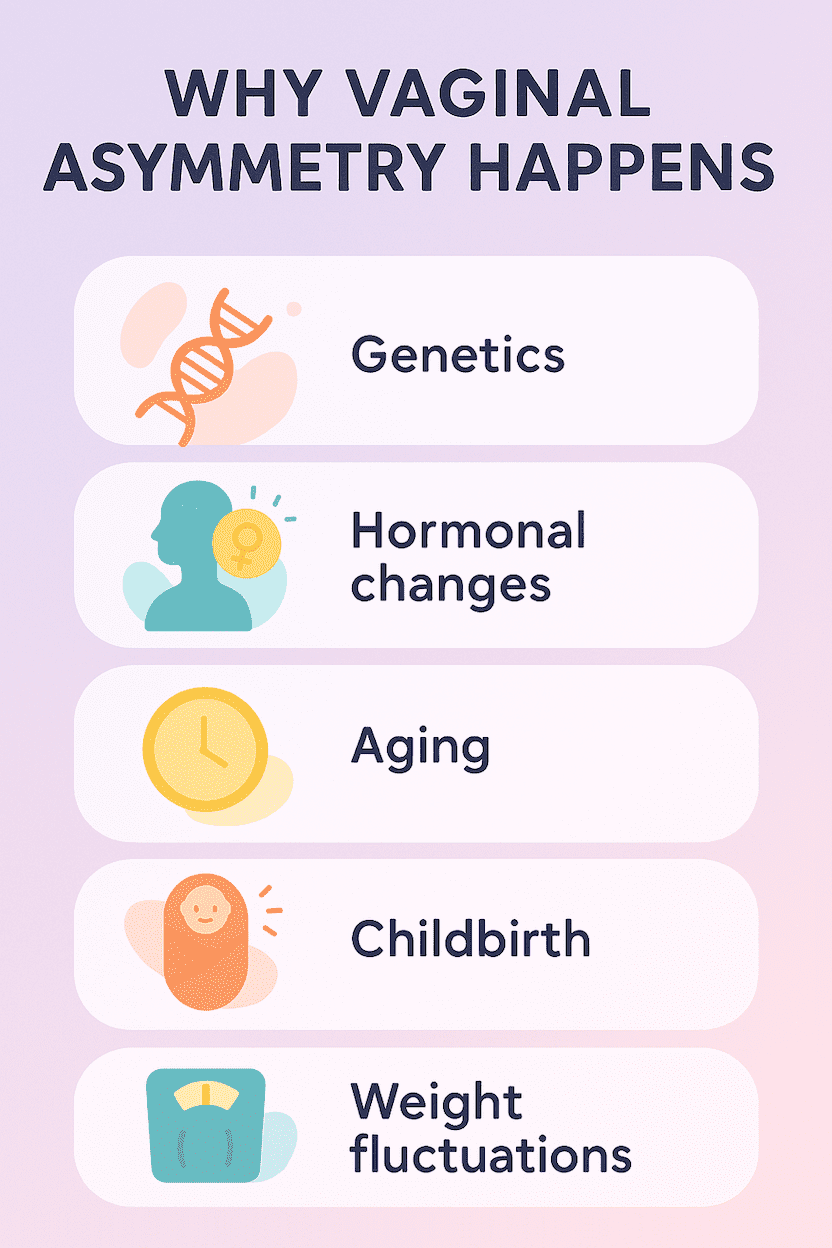Last update: November 4, 2025
8 minute read
Asymmetry and Uneven Vaginas: What's Normal, Myths, and When to See a Doctor
Worried about vaginal asymmetry? Most vulvas are naturally uneven. Learn what's normal, debunk common myths, and find out when you should talk to a doctor.

By Derick Rodriguez, Associate Editor
Edited by Yerain Abreu, M.S.

Ever looked down and thought something seemed... off? Maybe one labia looks bigger than the other, or things just don't seem perfectly symmetrical?
You're not alone, and more importantly, you're probably completely normal. Vulvar asymmetry is incredibly common, but because we don't talk about it openly, many people worry unnecessarily. This guide will help you understand what's typical, what's not, and when it's time to check in with a healthcare provider.
Key takeaways
- Most vulvas have some degree of natural unevenness in the labia, clitoral hood, or overall appearance
- Your anatomy changes throughout your life, and that's perfectly healthy
- Pain, irritation, or interference with daily activities are reasons to see a doctor, but visual asymmetry alone usually isn't
What does "lopsided" actually mean?
When people say "lopsided vagina," they're usually talking about the vulva (the external parts) rather than the vagina itself (the internal canal). The confusion is understandable since the terms get mixed up all the time.
Common types of asymmetry include:
- Labia minora (inner lips): One side might be longer, thicker, or shaped differently than the other
- Labia majora (outer lips): One side may be fuller or sit differently
- Clitoral hood: Can be uneven in size or in how it covers the clitoris
- Overall positioning: Everything might be slightly off-center
Here's the thing: if you lined up 100 people, you'd see 100 different vulvas. Some have prominent inner lips that extend past the outer ones. Others have tucked-in inner lips.
Colors range from pink to brown to purple. And yes, most are asymmetrical to some degree.

Why asymmetry happens
Your body isn't a factory assembly line, and that's by design. Several factors contribute to vulvar asymmetry:
- Genetics: Just like your face isn't perfectly symmetrical (check in a mirror, really look), your vulva developed with natural variations. One side might have slightly different tissue growth than the other.
- Hormonal changes: Puberty, pregnancy, menopause. Each of these life stages brings hormonal shifts that affect genital tissue. Estrogen levels particularly influence size, color, and texture.
- Aging: As you get older, tissue loses elasticity and fat distribution changes. What looked one way at 20 might look different at 40, and that's normal aging, not something wrong.
- Childbirth: Vaginal delivery can stretch and change vulvar tissue. Sometimes things bounce back, sometimes they don't, and sometimes one side changes more than the other.
- Weight fluctuations: The labia majora contain fatty tissue, so weight gain or loss can affect their size and appearance.
Common myths that need to be debunked
Myth 1: Symmetry means you're "normal" and asymmetry means something's wrong.
Wrong. Studies show that the majority of people have some degree of labial asymmetry. A perfectly symmetrical vulva is actually less common than an asymmetrical one.
Myth 2: Large or uneven labia mean you've had "too much sex."
This is anatomically impossible. Sexual activity doesn't stretch or permanently change labial tissue. Size and shape are determined by genetics and hormones, not behavior.
Myth 3: All vulvas should look like what you see in media.
Most images in porn, movies, or even medical illustrations show a narrow range of appearances. Real bodies are way more diverse. Plus, many images are digitally altered or show people who've had cosmetic surgery.
Myth 4: If it's asymmetrical, it must be a medical problem.
Asymmetry alone isn't a medical issue. It becomes one only if it causes physical symptoms like pain, chronic irritation, or difficulty with hygiene.
When asymmetry is just... anatomy
Most of the time, what you're seeing is simply how your body is built. You probably don't need medical attention if:
- There's no pain or discomfort during daily activities, exercise, or sex
- You're not experiencing unusual itching, burning, or irritation
- The asymmetry has been consistent (not a sudden change)
- You can maintain normal hygiene without issues
- Your clothing fits comfortably
It's completely normal
Even significant visible differences can be completely normal. Some people have inner labia that extend 2-3 inches beyond the outer labia. Others have barely visible inner lips. Both are normal.
When you should see a doctor
While asymmetry itself is usually fine, certain symptoms warrant a medical evaluation:
- Sudden changes: If things look dramatically different than they did a few months ago, get it checked. Sudden swelling, lumps, or changes in color could indicate infection, cysts, or other issues.
- Pain or discomfort: If asymmetry causes pain during sex, exercise (especially cycling or horseback riding), or when wearing certain clothing, talk to a gynecologist. There may be solutions.
- Skin changes: New bumps, lesions, sores, or areas of discoloration should be evaluated. Most are benign, but some require treatment.
- Hygiene difficulties: If the anatomy makes it hard to keep clean or leads to recurrent infections, that's worth discussing with a provider.
- Psychological distress: If concerns about appearance are significantly affecting your quality of life, mental health, or relationships, both medical and psychological support can help.
What to expect at the doctor's office
If you decide to schedule an appointment, here's what typically happens:
Your provider will perform a visual examination and may gently palpate (feel) the tissue to check for any abnormalities. They'll ask about symptoms, when you first noticed changes, and whether anything causes discomfort.
Most of the time, the exam takes just a few minutes and you'll hear, "Everything looks completely normal." That reassurance alone helps many people feel better.
If there is a concern, your doctor might recommend:
- Treatment for any infections or skin conditions
- Physical therapy if there's pelvic floor involvement
- Referral to a specialist for further evaluation
- Discussion of surgical options if symptoms are severe

Get your personalized vitamin recommendations in less than 3 minutes.
Get your personalized vitamin recommendations in less than 3 minutes.

The cosmetic surgery conversation
Labiaplasty (surgical reduction of the labia) has become more common in recent years. Some people pursue it for physical comfort, others for aesthetic reasons.
Things to consider:
Surgery always carries risks including infection, scarring, loss of sensation, and asymmetry (yes, surgery can create asymmetry even when trying to fix it). Results are permanent, and you can't undo them if you change your mind.
Many surgeons require psychological evaluation first to ensure you have realistic expectations and aren't responding to partner pressure or societal beauty standards that don't reflect anatomical diversity.
If you're thinking about surgery, ask yourself: Is this causing me physical problems, or am I responding to what I think I "should" look like? There's no wrong answer, but it's worth examining your motivations honestly.
Living comfortably with your body
Whether your asymmetry bothers you or you'd never noticed it until now, here are some practical tips:
- Choose comfortable underwear: Cotton fabrics and styles that don't create pressure points can help if you experience any rubbing or irritation.
- Use proper lubrication: During sex, adequate lubrication prevents friction and discomfort regardless of your anatomy.
- Skip the comparison game: Social media and porn create unrealistic standards. What you see online isn't representative of real anatomical diversity.
- Talk about it if you want: With partners, friends, or healthcare providers. Chances are, they'll tell you either that they've never noticed or that they have similar concerns about their own bodies.
Frequently asked questions (FAQ)
Here are some of the most frequently asked questions about vaginas.
Final thoughts
Your vulva is unique to you, and asymmetry is far more common than perfect symmetry. Unless you're experiencing pain, sudden changes, or other concerning symptoms, what you're seeing is almost certainly normal anatomy.
Bodies come in endless variations. Freckles, scars, birthmarks, and yes, uneven labia are all part of being human.
If you're worried, a quick check with a healthcare provider can give you peace of mind. But most likely, you'll hear what most people hear: "You're completely normal."
And if appearance concerns are affecting your well-being, that's valid too. Just make sure any decisions you make are truly for yourself, and that you have accurate information about what's normal before deciding something needs to be "fixed."
Sources and references
- Classification of labia minora hypertrophy: A retrospective study of 100 patient cases - ScienceDirect
- Labial Hypertrophy and Asymmetry - NASPAG
- The Size of Labia Minora and Perception of Genital Appearance: A Cross-Sectional Study - PubMed
- Is it normal for your vagina to be loose and look different after having sex a few times?
- Labiaplasty: Surgery, Recovery & What To Expect
Editor

Derick Rodriguez
Derick Rodriguez focuses on editing health and wellness-related content. With over half a decade of experience in the digital realm, Derick has developed a unique skill set that bridges the gap between complex health concepts and accessible, user-friendly communication. His approach is deeply rooted in leveraging personal experiences and insights to illuminate the nuances of health and wellness topics, making them more approachable and empowering readers with knowledge and confidence.
Editor

Yerain Abreu
Yerain Abreu is a content strategist with over seven years of experience. He earned a Master's degree in digital marketing from Zicklin School of Business. He focuses on medical and health-related content, working with top healthcare professionals to ensure content is engaging and reliable.
At VitaRx, we're not just passionate about our work — we take immense pride in it. Our dedicated team of writers diligently follows strict editorial standards, ensuring that every piece of content we publish is accurate, current, and highly valuable. We don't just strive for quality; we aim for excellence.
Related posts
While you're at it, here are some other relevant articles you might be interested in.

Get your personalized vitamin recommendations in less than
5 minutes.
Get your personalized vitamin recommendations in less than
5 minutes.






